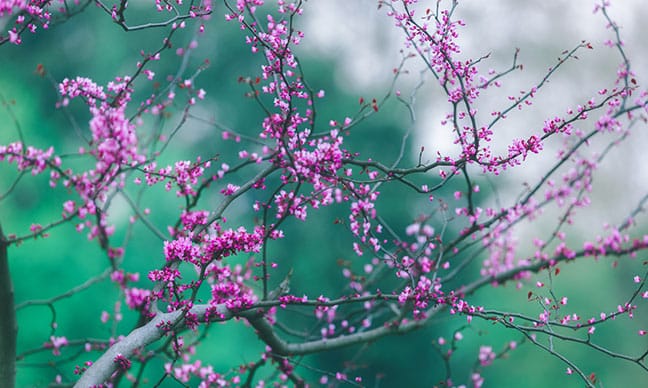Avondale Chinese redbud is one of the most profuse flowering redbud trees. It is characterized by very showy dark purple-rose flowers that usually cover up the stems of this sturdy, small tree in spring. The leaves are green, glossy, and commonly shaped like a heart and they fill the tree as the blooms fade. This deciduous tree fits easily into landscapes and is adapted to containers, too.
Keep reading to find out more about this beautiful decorative tree, its characteristics, maintenance requirements, and adaptability!
Related Post: Arizona Flowering Trees
Avondale Chinese Redbud – Characteristics and Attributes
Description
The Avondale Chinese redbud is originally native to the woodlands of southern and central China. It is known to grow to about 50 feet in its native habitat, where it usually acts as a woody tree. Still, due to different climate and soil conditions in the USA, it is most frequently found as an open shrub that reaches about 15 feet in height.
When it comes to appearance, it is closely related to the Cercis Canadensis that’s native to North America, but they still have certain distinctions. Generally, this decorative tree is characterized by a bit larger purplish flowers, longer seed pods, and is shorter in height than its North American relative.
However, both species bloom very early in Spring and this usually lasts about three weeks. During this time, this flowering tree produces a brilliant display of pink-purple, clustered flowers. After that, medium-sized, heart-shaped leaves will emerge and take over the landscape. We recommend consulting with a tree service Arizona and schedule regular trimmings during winter.
The leaves are bright green until fall when they turn yellow or orange. It is not necessarily the most attractive fall tree but will play a big part in your landscape. Besides, the tree produces bean-like seed pods that mature in late summer.
Related Post: Fall Colors In Arizona
This redbud is easily grown in well-drained soils and prefers full sun to part shade. Experts recommend moderately fertile soils with consistent and regular moisture. Also, part shade is recommended in hot summer climates, while full sun exposure allows for the best flower production.
Tree services Avondale recommend planting the tree in well-drained soil with regular, medium moisture, and make sure there’s not too much clay. This small tree works well when planted both as a single specimen or in small groups in naturalized areas and woodland gardens. Since it can be grown in containers, it can be used as a street tree in urban areas or be planted on a lawn.
The plant is known for being fairly easy to transplant. Usually, it takes a multi-stemmed shrub form, but some single trunk cultivars can also be found in nurseries. One of these cultivars is ‘Dong Egolf’, known for being sterile and a lot shorter than other Cercis Chinensis ‘Avondale’ varieties.
Pests, Diseases, and Maintenance
Cercis Chinensis ‘Avondale’ is generally pest-free. Still, like almost every other tree, it is susceptible to diseases like mildew, blights, leaf spots, or dieback. However, with regular pruning, fertilization, watering, and maintenance, you can be sure that your tree will be strong enough to deal with most of these problems.
In general, stressed trees are the most susceptible to developing diseases and suffering from pest infestation. This is why experts always urge tree owners to regularly prune and remove all dead wood in the area. We recommend hiring a tree pruning Avondale service to do the job for you, but if you are confident enough you can try doing it on your own too.
Pruning a flowering tree is always a bit different. Make sure you prune a few inches below infested areas to remove as much of the fungus as possible (if there’s any). Also, recently infected branches shouldn’t be removed since they may flush again.
Another important thing to do is good fertilization. Use a biostimulant or a redbud mycorrhizal to assist the tree in metabolizing nutrients and moisture. Also, good fertilization can even help the tree to develop a proper immune response to fungus and insect infestation.
Regular irrigation is important for the development and maintenance of this decorative tree. Make sure that the water penetrates deep into the soil, and the easiest way to do this is by placing a soaker hose or a sprinkler over the tree’s drip line.
FAQ
Q: Where is the best place to plant a redbud tree?
A: A planting side for Chinese redbud in Avondale should be at least 3 feet from fences and 25 feet from any existing structures. Besides, the spot should receive full sun with some afternoon shade. Also, a well-draining site with no standing water is recommended since the tree does poorly in soggy soil.
Related Post: Small Trees For Arizona
Q: How close to the house can you plant a redbud tree?
A: You should plant your Chinese redbud at least 25 feet from your house in Avondale. The reason for this is its spreading, shallow root system. By doing this, you will keep the outer branches away from the house and minimize the chances of root damage to the foundation.
Q: Can you overwater a redbud tree?
A: Redbuds are vulnerable to overwatering, especially when they are still young in Avondale. It is advised to plant trees with ground covers with similar needs in terms of water. Probably, the best thing to do is to use a drought-resistant ground cover and come up with a drip system that can provide water for both.
Local Tree Experts Overview
Avondale Chinese redbud is a beautiful, ornamental tree commonly used as a street tree for urban areas and as in private landscapes. It produces beautiful flowers in early spring that is later followed by bright green flowers. The tree has somewhat regular maintenance requirements, it is not hungry for water, and can withstand drought with almost no problems. Also, it is resistant to most pests and diseases in regular conditions. Still, we recommend consulting with your local arborist if you have any questions.




